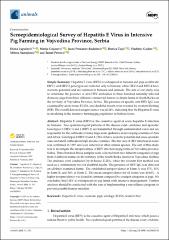Seroepidemiological Survey of Hepatitis E Virus in Intensive Pig Farming in Vojvodina Province, Serbia

View/
Date
2025Author
Lupulović, Diana
Gnjatović, Marija
Prodanov-Radulović, Jasna
Ćujić, Danica
Gajdov, Vladimir
Samojlović, Milena
Petrović, Tamaš
Metadata
Show full item recordAbstract
Hepatitis E virus (HEV) is the causative agent of acute hepatitis E infection
in humans. Two epidemiological patterns of the disease exist—endemic and sporadic.
Genotypes 1 (HEV-1) and 2 (HEV-2) are transmitted through contaminated water and are
responsible for the outbreaks of many large-scale epidemics in developing countries of Asia
and Africa. Genotypes 3 (HEV-3) and 4 (HEV-4) have zoonotic potential and cause sporadic
cases and small outbreaks in high-income countries. The first case of HEV infection in swine
was confirmed in 1997 and later detected in other animal species. The aim of this study
was to investigate the seroprevalence of HEV infection in pig farms in Vojvodina province,
Serbia. Three hundred blood samples were collected from five different categories of pigs
from 3 different farms on the territory of the South Baˇcka district in Vojvodina (Serbia).
The analyses were conducted by in-house ELISA, while the western blot method was
used as a confirmatory test for doubtful results. The presence of HEV IgG was detected
on all three examined farms. The established seroprevalence in Farm A was 37%, 31%
in Farm B, and 54% in Farm C. The mean seroprevalence for all farms was 40.66%. A
higher seroprevalence was found in fatteners compared to younger categories of pigs. We
concluded that HEV is widespread on pig farms with intensive management. Further
analyses should be conducted with the aim of implementing a surveillance program to
prevent possible human infection.
